Before reading this piece, I’d urge you to read the following posts:
Candlestick Formations
How To Set a Candlestick Time Period on Charts
A part of this article is based on a technical session conducted by Rajan Kamboj. The rest is based on what I know and practice.
1: DOJI IN A BEAR MARKET
To help you understand how you can spot trade-able stocks using this formation, I have chosen the HPCL Candlestick chart of 2001 and have set the Candle time period to 1 Day.
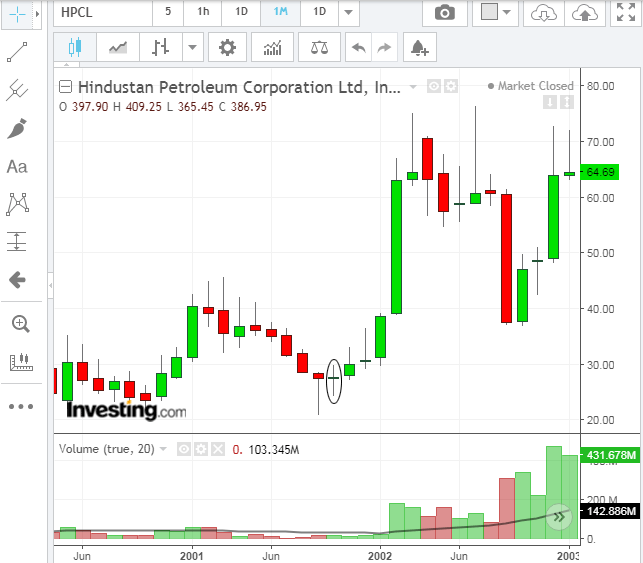
The Doji-in-a-bear-phase can also be used by intraday traders by adjusting the candlestick time periods in their charts. 15-minute Candles for those who trade several times in a day or 1 hour Candles for those who trade no more than 1-2 times in a day.
HOW TO TRADE THE DOJI IN A BEAR MARKET
- Watch from the sidelines
- Invest 10%-20% of your allocation for that stock and watch subsequent candles
- Consider it as a reversal signal and stand by to act based on subsequent charts and price action
2: DOJI IN A BULL MARKET
Let’s check out Reliance Power’s 1-day chart to help understand the importance of a Doji in a bull market.
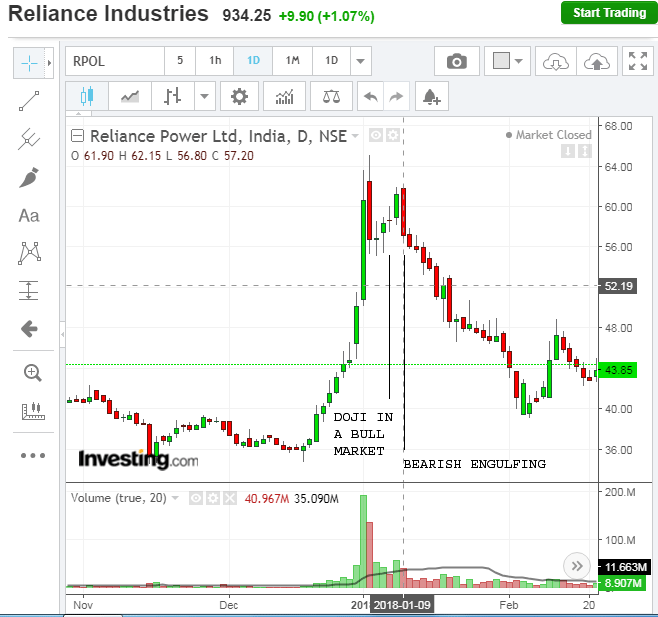
HOW TO TRADE THE DOJI IN A BULL MARKET
- Book 40%-50% of your holding in that stock and watch subsequent candles
- Consider it as a reversal signal and stand by to act based on subsequent charts and price action
3: BEARISH ENGULFING CANDLE
In theory, a bearish engulfing candle’s price first tests the previous day’s high, and then sellers hammer it and drag it below the the previous day’s low.
On charts, a bearish engulfing candle completely covers the prior candle. Let’s check this chart out:
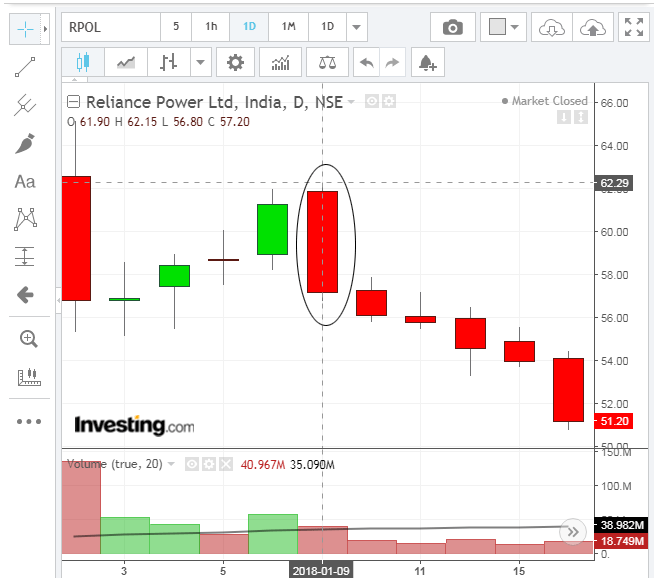
HOW TO TRADE THE BEARISH ENGULFING CANDLESTICK
- If the general market trend is bullish, and you are making handsome profits, sell 40%-50% of your holding and watch subsequent candles. The candle can also be used to book losses or shorting, depending on your investment strategy.
- If the market trend is bearish, book profits and hold on to free shares so long the stock is high quality. Can book losses too. Can try shorting as well.
4: BULLISH ENGULFING CANDLE
In theory, a bullish engulfing candle’s formed when the price of a stock moves above the high and low price of the previous day’s candle.
On charts, a bullish engulfing candle completely covers the prior candle. Let’s check this chart out:

HOW TO TRADE THE BULLISH ENGULFING CANDLESTICK
- This is a buy signal in any market so long the candle is supported by rising volumes. However, in a bear or choppy market, you should ideally validate it by checking MACD and RSI.
- If the market trend is bearish, book profits and hold on to free shares so long the stock is high quality. Can book losses too. Can try shorting as well.
5: GREEN MARBOZU
A green Marbozu is a full bodied green-colored candle (no wicks). It’s an extremely bullish signal in any market.

HOW TO TRADE THE GREEN MARUBOZU
- This is a buy signal in any market so long the candle is supported by rising volumes.
6: RED MARUBOZU
A red Marubozu is a full bodied red-colored candle (no wicks). It’s an extremely bearish signal in any market. It’s very difficult to find a red marubozu in a bull market for a prominent stock. But I’ve something that’s close to one.
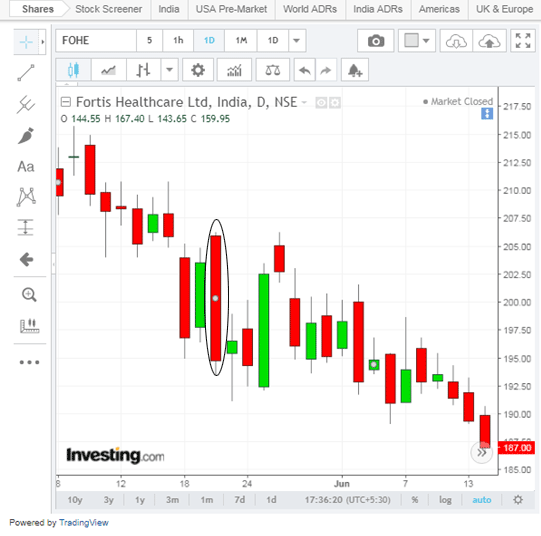
HOW TO TRADE THE RED MARUBOZU
- This is a SELL signal in any market so long the candle is supported by above-average volumes.
Well, these chart formations should hep investors reach some conclusions about any stock. Remember that candle formations do not work for illiquid stocks. If you read and practice the 2 articles liked at the top + this article, you will be able to spot stocks that can appreciate or depreciate.

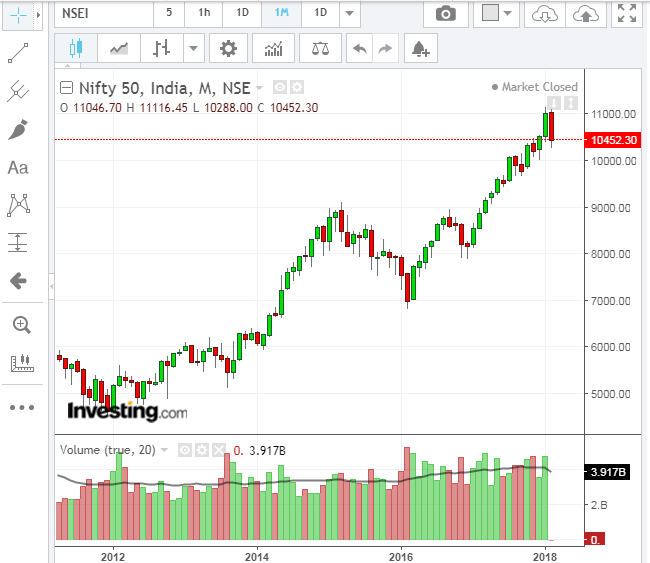
Dear Sunil ji you doing great service to new investors keep it up
Sir once again thanks for your knowledge sharing.My query is regarding Bullish Marubozu.On 14/02/18 Nelco formed marubozu with huge volume but after that it’s in downtrend.plz explain this
It did retrace yesterday. Markets are choppy/weak these days and the trend is uncertain. In such a trend, sell-side technicals work better. In any case, you are referring to a 1-day Marubozu, and therefore should wait it out for at least a couple of weeks. Apply a 10%-15% SL.
sir your doing great service to new investors
Sunil ji, i just started reading articles and explanation given in your articles. a great work and i appreciate the way you explain, it clearly gives ways to understand and make decisions on the facts.
my little suggestion, please ask someone to proofreading before posting it. there are some confusions e.g in 1: DOJI IN A BEAR MARKET :- you wrote you have used 1 day candles whereas it was 1M !!
2: DOJI IN A BULL MARKET :- you wrote Reliance industries but chart is for Reliance power !!
not complain but just an suggestion so that beginner like me should note get confusions.
regards
🙂
Rectified (1)
(2) is okay because in Investing.com, the name of the stock that was analyzed first remains fixed at the top.